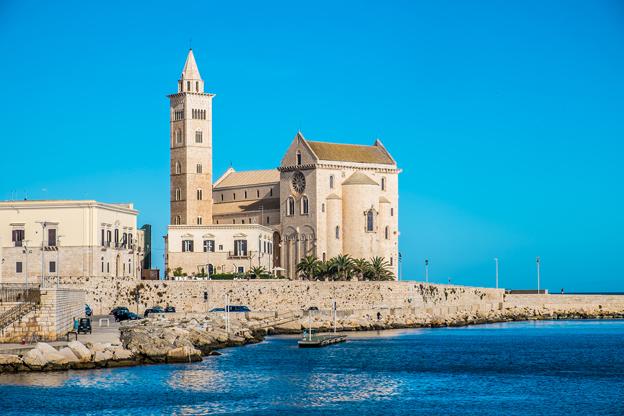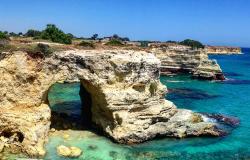They look like fortresses, their white stones shining against the blue backdrop of the sea. The cathedrals built along the coast to the north of Bari in Puglia date to 1,000 years ago, when the maritime cities of the area constituted important crossroads for the flourishing trades between East and West. As the cities became wealthy, beautiful, imposing churches were built near the harbors, well visible at a distance by sailors, with their soaring towers against the clear sky of Puglia.
The model for these churches is in Bari, five minutes from the water, set among the alleys of Bari Vecchia (Old Bari): the Basilica of San Nicola, a perfect example of Apulian Romanesque style. The church was built in 1087 to guard the relics of San Nicola, patron saint of the city, which were smuggled during an expedition by Baresi sailors to Nicola’s hometown, Mira, on the coast of Asia Minor (present-day Turkey). The church was built quickly, and quickly became a popular pilgrimage site, which still is today, both for Roman Catholics and Orthodox Christians from Eastern Europe.

The Basilica houses some of the most noteworthy Romanesque sculptural works of southern Italy: the cathedra (bishop's throne), built in the late 11th century for the abbot Elias, and the ciborium (canopy), the most ancient in the region, decorated with mosaics. There are precious mosaics in the crypt as well, where the relics of St. Nicholas are housed.
The Basilica di San Nicola would inspire other churches built in the maritime villages on the coast to the north of Bari.
Leaving Bari, the first you find is in Giovinazzo. The Cathedral dedicated to Santa Maria Assunta overlooks the sea from the edge of the small historic center. White, with pure Romanesque forms, the cathedral stands out against the alleyways with its two asymmetrical towers. The best vantage point to admire it is from the western pier in the little harbor, which is where the seafront promenade begins, with an alternation of rocks and tiny sandy beaches.

Next up is Molfetta, one of the main maritime centers of the lower Adriatic. The harbor is dominated by the identical towers of the Duomo di San Corrado, erected between 1150 and the end of the 13th century, right by the sea. Before the harbor docks were constructed, the severe western façade of the church was right above the Adriatic, and the tower closest to the sea was used as a watchtower. The stark white-azure colors outside contrast with the fresh shade inside, where you can almost perceive the scent of the sea.

Proceeding north along the coast is Trani, where the Cathedral of San Nicola Pellegrino soars isolated above the sea, a great example of Apulian Romanesque architecture. Construction began in 1099, over the earlier church of Santa Maria della Scala (4th century), and, for more than 1,000 years, the building represented a reference point for sailors. Its surfaces, reflecting light and taking on different hues according to the time of the day, are made of the local calcareous stone of Trani, extracted from the subsoil of the nearby Murgia plateau, which is white as ivory, with light yellow and pink veins.

Do not leave until sunset: this is when the Cathedral of Trani looks its best, with the stone taking on many different shades of pink.



